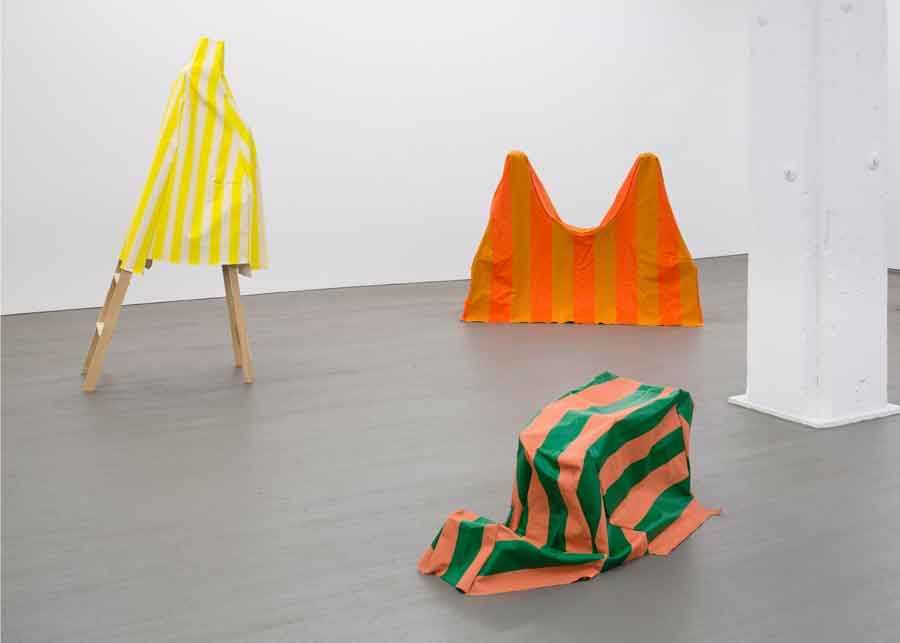The Los Angeles-based artist Math Bass works between painting, performance, sound, video and sculpture. In Bass’s work the body is in question. Is the body present or absent? Is the body a disembodied voice or a hooded and shielded spectre, audible but not visible, visible but covered in fog surrounded by a pack of barking dogs performing alongside a pack of humans singing? And then there are hard-edged paintings in which space and colour are flat, flat, flat and the canvas plays tricks on your eyes, forming faces made from collections of interchangeable symbols such as smoke, fire, alligators, matches, razor blades, cigarettes and the letter ‘z’.
For Body No Body Body (2012), Bass covered handcrafted A-frame ladders with irregularly shaped striped canvases sewn together on three sides. The encounter with these objects is a lot like seeing a puppet on stilts, or even one or more persons lying down in a crouched huddle: you can see them, but they can’t see you. The headless bodies do something else that’s curious.
For Angelenos it is a familiar sight to encounter a house covered by a striped tarp. When you are new to the city, you wonder what the tent is concealing, only to find out that they are protecting the neighbourhood from house ‘bombings’, aka chemicals that are being gassed into the tarps in order to exterminate termite infestations. While this geographic reference may be lost on some, the painted canvas coverings-cum-sculptures in Bass’s installation still yield a dubious presence, passing as both menacing and festive – like bodies caught hiding in plain sight seeking privacy, protection or still something else not meant for public display.
For Brutal Set, a performance produced and performed at the Hammer Museum for the 2012 Made in LA exhibition, a collection of single and A-frame ladders were used as props and supports alongside concrete casts of inverted jean trousers and shorts, and a terracotta potted plant, the one ‘living’ element, apart from the performers themselves, to populate the otherwise brutal set. As the performers moved about the space in a random pattern of loose choreography, they sang the lines: “Who say you have to be a dead dog… One is the loneliest number that you’ll ever do… And it comes down, it comes down, well it comes down, and it comes down, it comes it comes… Scores of blood and fire and freeways, I am going to get my share… One is the loneliest number that you’ll ever do… Who say you have to be a dead dog…” Handling each other’s bodies with as much regard as the set’s props, the performers alternate between a cappella and in-the-round chorus, fugue and eventually total discordance, rising as high as Math Bass as she climbs to the top of the ladder supported by her full cast in order to smash the plant and end the performance.
Originally published in the March 2014 FutureGreats issue, in association with EFG International
